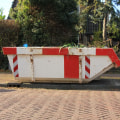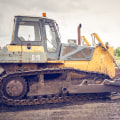The forestry cutter's tube-style drum and spiral tooth pattern allow one tooth to engage at a time, so operation is smooth and less horsepower is required to get the job done. Simply lower the forestry mower onto the tree and its fast-cutting teeth will shred it to shreds, turning it into a bed of mulch that slows growth and provides organic material. The compact size of the forestry cutter allows for any type of removal work, whether cleaning all the trees in an area or selectively thinning the stands.
How much does a bobcat forestry cutter cost?
Jenifer Sonnenberg26/08/20220 minutes 27, seconds read0 CommentsMore Posts
How Professional Pest Terminators Are Beneficial To Forestry Mulching In Calgary
7 minutes 11, seconds readForestry Mulching Benefits: Reducing Land Leveler Cost
7 minutes 11, seconds readWhy Forestry Mulching Matters In Modern Tree Removal Services In Austin
6 minutes 50, seconds read- Home
- Newest Posts
- How much does a bobcat forestry cutter cost?
- What is forestry mulching?
- Can a forestry mulcher grind stumps?
- How do you estimate a forestry mulching job?
- How much does forestry mulching cost?
- How to get forestry mulching contracts?
- From Overgrown To Outstanding: How Forestry Mulching In Pembroke Pines Is Reshaping Tree Service And Landscaping
- The Best Skid Steer Loaders For Forestry Mulching
- How many horsepower does it take to run a forestry mulcher?
- What do forestry mulchers do?
- Which garden mulcher is best?
- How Professional Pest Terminators Are Beneficial To Forestry Mulching In Calgary
- Enhance Your Property With Professional Stump Removal And Forestry Mulching Services
- Is forestry mulching good for soil?
- Why Forestry Mulching Matters In Modern Tree Removal Services In Austin
- What Role Does Stump Grinding Services Play In Sustainable Forestry Mulching Practices In Portland
- How to bid forestry mulching jobs?
- From Landscaping To Forestry: Crane Hire Services And Forestry Mulching Solutions In Geelong
- Forestry mulching pros and cons?
- How big of a tree can a forestry mulcher handle?
- Sprinkler And Irrigation System Installation In Omaha: Enhancing Your Landscape With Forestry Mulching
- What is the purpose of forestry mulching?
- Save Time And Money With A Dumpster Rental Alternative For Your Forestry Mulching Project In Boise, ID
- Perks Of Contracting A Dumpster Rental Company To Rent Trash Containers While Doing Forestry Mulching In Duncanville, Texas
- How many acres can a forestry mulcher clear in a day?
- Bethany's Ecosystem Heroes: Tree Maintenance Service And Forestry Mulching
- What is forest mulch used for?
- Will trees grow back after forestry mulching?
- Transform Your Property with Forestry Mulching in Portland
- Will grass grow after forestry mulching?
- Can you make money forestry mulching?
- The Benefits Of Partnering With A Lawn Care Company After Forestry Clearing In Northern Virginia
- Why Choose Professional Tree Maintenance Services In Belle Isle For Forestry Mulching
- The Benefits Of Forestry Mulching: Paradise Valley's Go-to Professional Tree Service
- Preserving Leesburg's Natural Beauty: How Tree And Land Clearing Experts Contribute To Forestry Mulching
- Discover Forestry Mulching & Robotic Pipeline Cutting in Vancouver
- Is a forestry mulching business profitable?
- Las Vegas Pest Extermination: Why Forestry Mulching Isn't Enough
- Forestry Mulching Benefits: Reducing Land Leveler Cost
- How To Exterminate Raccoons While Doing Forestry Mulching In Houston
- How big of a skid steer do you need for a forestry mulcher?
- What size bobcat do you need for forestry mulcher?
- How much does a good mulcher cost?
- How big of a tree can a forestry mulcher take?
- What does mulching land mean?
- How fast can you clear land with forestry mulcher?
- How long does forestry mulch take to decompose?
- Will a forestry mulcher grind stumps?
- Preserving Groveland's Greenery: The Role Of Forestry Mulching In Professional Tree Care Services
- How big of a tree can a skid steer mulcher handle?
- How A Lawn Care Service Provider With Forestry Mulching Expertise Can Transform Your Landscape In Derry?
- How much does a forestry mulcher attachment cost?
- What does forestry mulching do?
- What size skid steer do you need for a forestry mulcher?
- What is the biggest forestry mulcher?
- How long does it take to clear an acre with a forestry mulcher?
- Forestry Mulching In Portland, OR: Why Professional Tree Service Matters
- How big of a tree can a forestry mulcher cut?
- What is forestry mulching good for?
- Can you use a forestry mulcher in the rain?
- What to plant after forestry mulching?
- Maximizing Efficiency: The Role Of Lubbock Tree Removal In Forestry Mulching Projects
- Innovative Ways To Employ Watering Systems For Gardens In Forestry Mulching Projects In Northern VA
- How A Tree Care Company Can Improve Your Property With Forestry Mulching In Damascus, Oregon?
- Is forestry mulching good for the land?
- How Forestry Mulching And Tree Services Go Hand In Hand To Create Pristine Landscapes In Ellisville, MS
- From Mulched To Magical: Upgrading Your Melbourne Yard With Landscape Lighting After Forestry Mulching
- What to charge for forestry mulching?
- Forestry Mulching And Landscape Lighting Synergy: Creating Portland, OR's Most Beautiful Yards
- The Essentials Of Forestry Mulching: Everything You Need To Know In Louisville
- How much does a bobcat forestry cutter cost?



